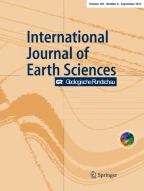Abstract
Post-nappe brittle structures across the Austroalpine–Penninic wedge are representative of two principal deformation stages. The former (D1) developed during the Late Oligocene, the latter (D2) from the Miocene to the Present. Major D1 features are the E–W Aosta–Ranzola half-graben and the NE–SW Ospizio Sottile subvertical normal fault system. Oligocene extension was also characterized by hydrothermal activity and intrusion of calc-alkaline to ultra-potassic dikes. From the Miocene onwards (D2), the Ospizio Sottile system was re-activated as a SE sinistral boundary of the Pennine–Graian Alps block of nappes, bodily moving away from the Simplon detachment to the SW. Inside the escaping block, a number of D2 slightly diverging sublatitudinal splays (Aosta–Piccolo San Bernardo system) was generated, as well as a regular set of NW-trending normal faults from the Simplon to the Gran Paradiso massif. Instead, the Aosta–Ranzola system was poorly reworked in that time. More generally, the short-lived Oligocene extension (D1) was associated to slab break-off of lower plate, wedge rebound, rapid uplift and thermal perturbation. From the Early Miocene onwards the Oligocene extension was replaced by renewed compression, allowing the vertical extrusion of the Lepontine dome and lateral escape of the overlying Pennine–Graian Alps block.
Similar content being viewed by others
Author information
Authors and Affiliations
Additional information
Electronic Publication
Rights and permissions
About this article
Cite this article
Bistacchi, A., Dal Piaz, G., Massironi, M. et al. The Aosta–Ranzola extensional fault system and Oligocene–Present evolution of the Austroalpine–Penninic wedge in the northwestern Alps. Int J Earth Sci 90, 654–667 (2001). https://doi.org/10.1007/s005310000178
Received:
Accepted:
Published:
Issue Date:
DOI: https://doi.org/10.1007/s005310000178
